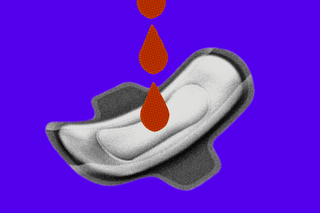
This Whole Time, Period Products Didn’t Use Actual Human Blood to Test Efficacy
The first study to use actual human blood to test the efficacy of period products was just published this month.

Menstrual products have been in use for a long, long time; reports point to 20 patents drawn out for them between 1854 and 1915. Interestingly, though, their much-advertised absorption capabilities weren’t based on actual tests involving human blood. The first study to use human blood to test the efficacy of period products was just published this month in the British Medical Journal’s Sexual and Reproductive Health.
“No study exists comparing the capacity of currently available menstrual hygiene products using blood. Utilizing actual menstrual blood to test the collection capacity of menstrual hygiene products would be challenging, but blood products are a closer approximation than water or saline,” the authors noted.
Until now, traditional substitutes for menstrual blood in research were saline water or, well, just water, The Guardian reported. Unfortunately, they weren’t too helpful in determining the products’ absorption capacities because neither is nearly as viscous as menstrual blood, which includes not just blood cells, but also secretions and tissue from the shedded endometrial lining. To address the gaps thus created in our understanding of how well menstrual products absorb actual blood, the present research involved two trials: the first one used O+ blood that expired 33 days prior, and the second one re-used the same unit of blood that had, by then, expired 58 days ago.
The result: menstrual discs may be better-equipped to handle heavy flow, compared to pads, tampons, and period underwear.
Hailing the new study for providing “practical, clinically relevant information to help patients match a product with their own menstrual protection needs, and better plan for the expense,” Dr. Paul Blumenthal, an Emeritus professor of obstetrics and gynecology at Stanford University, wrote in an editorial, “[H]aving data-driven estimates of menstrual product capacity was all the more important when you consider that menstruators carry the financial burden of accessing and purchasing menstrual products, pain control modalities, laundry and other menstrual hygiene items… Saline absorption is a surrogate for menstrual blood, but it is not a clinically meaningful endpoint that measures how a patient feels or functions with the tampon.”
Related on The Swaddle:
Is Delaying, Suppressing Periods Worth the Risk?
Until 2017, sanitary napkin brands across the world shied away from even depicting menstrual blood as red — despite advertising the products’ blood-absorption capacity — in their ads. Meanwhile, India had to wait until 2020 for its first ad that didn’t pretend people bled blue on their periods. “A woman’s uterus isn’t a test tube, we aren’t bleeding blue. It is so important to normalize blood,” Afshan Shaikh, the director of the Indian ad, had told The Times of India.
It shows how research on menstrual products has lagged behind public usage requirements considerably, and for too long. Just last year, a new report revealed how a number of India’s most popular sanitary pads contain toxic chemicals that can induce severe health issues in consumers — an alarming discovery since the vagina, being a mucous membrane, is highly permeable, and can absorb the toxins at a much higher rate than, say, merely the skin. Yet, despite the sanitary napkin market in India being valued at around US$618.4 million in 2021, this pertinent information eluded us.
However, given that periods are largely considered a “women’s problem,” and medical science has a tendency to routinely ignore women’s health, it’s hardly surprising that any helpful research on period products is hard to come by. During the pademic, too, it had taken thousands of women to experience disruptions in their periods, and experts questioning data gaps and advocating for deeper investigations, before scientists studied the impact of the Covid19 vaccines — and the infection itself — on people’s menstrual health.
Hopefully, however, research will continue in its present stride, affording people the information they need to make the right choice for themselves. “If you go to the store and you want to buy some salsa or hot sauce, there are standardized approaches to measuring the hotness of those products,” Blumenthal noted, explaining that, similarly, “menstruators might make different decisions if they were forewarned or forearmed with respect to the capacity of a given [period] product.”
Devrupa Rakshit is an Associate Editor at The Swaddle. She is a lawyer by education, a poet by accident, a painter by shaukh, and autistic by birth. You can find her on Instagram @devruparakshit.
Related


TMI: People Tell Us What Masturbation Showed Them About Their Bodies
